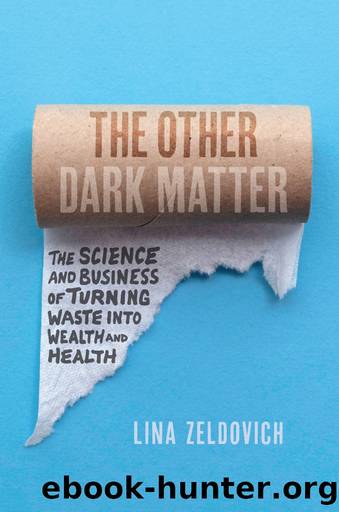The Other Dark Matter by Lina Zeldovich

Author:Lina Zeldovich [Zeldovich, Lina]
Language: eng
Format: epub
Tags: SCI000000 Science / General, SCI026000 Science / Environmental Science (see Also Chemistry / Environmental), SCI010000 Science / Biotechnology, SCI092000 Science / Global Warming & Climate Change
Publisher: University of Chicago Press
Published: 2021-11-05T00:00:00+00:00
Biogas Biology
Biogas technology appears simple, but the actual inner workings of a digester comprise a complex, multiphased, and tightly interconnected set of biological process involving numerous bacterial species, both harmless and dangerous. Even though some bacteria in the digester are similar to those found in human guts, overall, the microbial menagerie living in a typical digester can be quite pathogenic. Species isolated from anaerobic digesters include Clostridium, Bacillus, Staphylococcus, Streptococcus, Pseudomonas, Actinomyces, and Escherichia coli, all of which have pathogenic strains. But other beneficial microorganisms, including those that normally dwell in the human gut, have been found in digesters, too, including well-known probiotics such as Lactobacillus, which improves digestion, and Bifidobacterium, which actually fights E. coli.
Once I finally delve into the anaerobic digestion process, I understand why no one could explain it to me in just a few words. The molecular reactions stretching across pages of text are indeed so complex they can confuse a chemist unfamiliar with this particular topic.
As one paper explained, anaerobic digestion is a process in which organic matter is broken down by a consortium of microorganisms in the absence of oxygen, yielding simpler chemical compounds and biogas, which consists mainly of methane and carbon dioxide. But itâs a chain of reactions, involving complex organic and inorganic chemistry, that scientific literature breaks down into three phasesâor sometimes even four, because one of the phases can be split into two steps.
The first phase sludge goes through is hydrolysis. During this phase, large organic molecules dissolved in waterâsuch as carbohydrates, cellulose, proteins, and fatsâare decomposed by acid-producing bacteria into smaller compounds. Using specific hydrolytic enzymes, some of which are present in our own stomachsâlike amylase and lipaseâthe acidogenic bacteria break down proteins into lipids and amino acids, and complex sugars into simple ones.
The next phase is called acidification, which some scientific literature splits into two steps: fermentation and acetogenesis. In this phase, the fermenting bacteria and the acid-producing bacteria work together. The fermenting species produce what the acid-forming ones need to break the organic compounds down further into amino acids, alcohols, and other compounds. As one might expect, these bacteria produce several types of acidsâbutyric, propionic, and acetic acidâall of which contain carbon in various forms. In the process, they also release carbon dioxide and hydrogen.
The hydrogen and the acids become food for methanogens. Scientifically speaking, these methanogens arenât bacteria. They are archaea, a different, older form of microorganisms that live only in anaerobic environments. The methanogens sit at the last phase of this microbial conveyor belt.
The methanogens like their food simple. They canât break down and metabolize complex organic materials, but they can synthesize methane from the hydrogen and simple carbon-containing compounds the acidogenic bacteria have produced. And although they are picky eaters, they are a rather varied species of at least several different strains with diverse appetites. They feed on hydrogen, acetic acid, carbon dioxide, and carbon monoxideâalong with a few other carbon-containing chemicalsâand convert them into methane gas, with the chemical formula CH4.
The digesterâs bacterial communities are highly interdependent.
Download
This site does not store any files on its server. We only index and link to content provided by other sites. Please contact the content providers to delete copyright contents if any and email us, we'll remove relevant links or contents immediately.
| Anatomy | Animals |
| Bacteriology | Biochemistry |
| Bioelectricity | Bioinformatics |
| Biology | Biophysics |
| Biotechnology | Botany |
| Ecology | Genetics |
| Paleontology | Plants |
| Taxonomic Classification | Zoology |
Sapiens: A Brief History of Humankind by Yuval Noah Harari(14257)
The Tidewater Tales by John Barth(12609)
Mastermind: How to Think Like Sherlock Holmes by Maria Konnikova(7232)
Do No Harm Stories of Life, Death and Brain Surgery by Henry Marsh(6891)
The Thirst by Nesbo Jo(6832)
Why We Sleep: Unlocking the Power of Sleep and Dreams by Matthew Walker(6620)
Life 3.0: Being Human in the Age of Artificial Intelligence by Tegmark Max(5478)
Sapiens by Yuval Noah Harari(5295)
The Longevity Diet by Valter Longo(5021)
The Body: A Guide for Occupants by Bill Bryson(4978)
The Rules Do Not Apply by Ariel Levy(4866)
The Immortal Life of Henrietta Lacks by Rebecca Skloot(4528)
Animal Frequency by Melissa Alvarez(4399)
Why We Sleep by Matthew Walker(4362)
The Hacking of the American Mind by Robert H. Lustig(4319)
Yoga Anatomy by Kaminoff Leslie(4309)
All Creatures Great and Small by James Herriot(4233)
Double Down (Diary of a Wimpy Kid Book 11) by Jeff Kinney(4209)
Embedded Programming with Modern C++ Cookbook by Igor Viarheichyk(4107)
